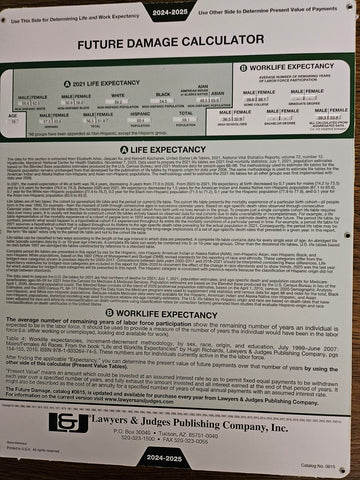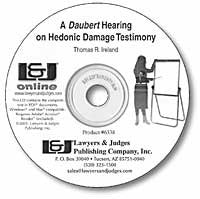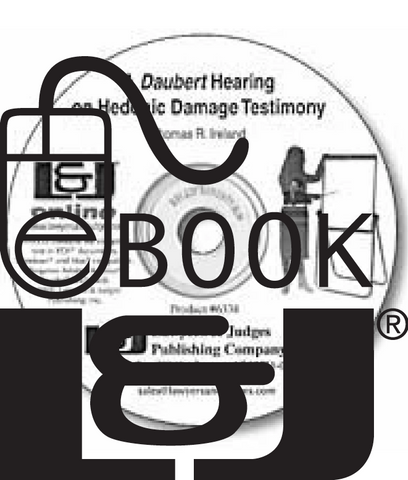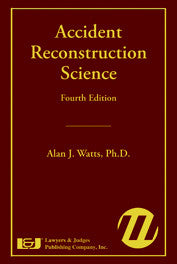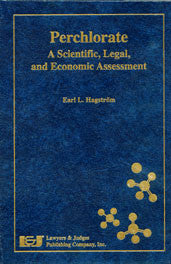
Perchlorate: A Scientific, Legal, and Economic Assessment
-
Author: Earl L. Hagström
-
ISBN 10: 1-930056-84-2
-
ISBN 13: 978-1-930056-84-8
-
Copyright Date Ed: March 1, 2006
-
Pages: 480 pages
-
Binding Information: Hardcover
- Size: 6 ✕ 9 Inches (US)
Perchlorate, a naturally occurring and synthesized chemical, is generating intense publicity, scientific debate, regulatory scrutiny and litigation across the United States. The substance has been widely used for over 60 years in the production of rocket fuel, flares, fireworks, electronics and munitions, but did not emerge as a significant environmental issue until the mid-1990s, when improved analytical testing methods permitted its detection in groundwater at 4 parts per billion. As of 2005, perchlorate has been detected in 49 of the 50 states and is the focus of mounting regulatory enforcement actions and widespread civil litigation.
Perchlorate's effects on human health and the environment are hotly debated in the medical and environmental communities. Neither state nor federal regulators have been able to agree upon a "safe" level of perchlorate in water supplies. Authorities do agree that, once in water, perchlorate can persist for several decades and migrate through aquifers at the same rate as groundwater. Given its pervasive nature and potential adverse impact, disputes over remediation requirements and the basis for imposing liability continue despite the absence of uniform regulatory standards.
Perchlorate: A Scientific, Legal, and Economic Assessment is designed to educate and inform business, environmental, legal and academic audiences about the history and development of the perchlorate controversy and provide practical advice and guidance to those involved in perchlorate litigation, remediation and regulation. Written by environmental and toxic tort attorneys, scientists, engineers and medical specialists, the book addresses legal, scientific, economic and health aspects of perchlorate. Starting with a discussion of perchlorate sources and paths of release into the environment, the authors cover potential health effects in humans and animals, current and historical trends in environmental regulation, methods of determining contamination levels and current remediation technologies.
The book also identifies and discusses existing and anticipated liability theories and damage claims asserted in perchlorate litigation. The authors explain the theories of environmental liability, identify the tort claims most commonly asserted in environmental litigation, and provide an overview of environmental class actions. The book includes chapters covering key practical issues raised in perchlorate litigation, such as estimating monetary damages, the retention and use of experts, and obtaining insurance coverage for liabilities. These important topics will assist legal professionals involved in current perchlorate litigation and provide a broad base of knowledge to apply in future environmental contamination litigation.
This book is also available as an eBook. Click here to purchase and download:
Table of Contents
Chapter 1: Sources of Perchlorate Releases to the Environment
1.1 Introduction
1.2 Historical Perchlorate Uses
A. Milestones in perchlorate use
B. Common perchlorate compounds
1.3 Perchlorate Sources and Uses
A. Research methodology
B. Urban legends
1.4 Applications of Source and Use Information
A. Characterization
B. Remediation
C. Other applications of source identification
D. Source identification
1.5 Summary of Uses and Sources
1.6 Review of Perchlorate Chemistry
1.7 Discussion of Perchlorate Sources and Uses
A. Confirmed commercial sources and uses for perchlorates
B. Perchlorates as impurities in other products or by-products of other uses
C. Unconfirmed or experimental sources and uses of perchlorates
D. Reported but unlikely commercial sources and uses of perchlorates
Chapter 2: Current Issues in Perchlorate Analysis
2.1 Introduction
2.2 History of Perchlorate Analysis
2.3 Recent Developments in Perchlorate Analysis and Agency- approved Methods
2.4 The Perchlorate Regulation Process and Analytical Method Development
2.5 Sources of Analytical Challenges in Perchlorate Analysis
A. Interferences due to high TDS (conductivity)
B. Interferences due to organic molecules
C. Interferences due to microorganisms (perchlorate preservation)
D. Interferences resulting in false positive results
E. Stretching the limits of perchlorate measurement..
2.6 Future Trends in Perchlorate Analysis
2.7 Keys to Defendable Perchlorate Results
A. Verify sample preservation
B. Verify the sample TDS and/or conductivity
C. Verify results using alternate reporting method
D. Familiarize the laboratory with the sample matrix
E. Use the appropriate analytical method
F. Consider developing (not production level) analytical methods
2.8 Conclusion
Chapter 3: The Toxicology of Potential Human Health Effects Associated with Perchlorate in Drinking Water
3.1 Introduction
A. Physicochemical properties
B. Uses
C. Key regulatory events since 1997
3.2 Toxicokinetic Properties of Perchlorate and Mode of Action
A. Toxicokinetics
B. Mode of action
3.3 Animal Toxicity Data
A. Immunotoxicity
B. Thyroid hormone levels
C. Developmental neurotoxicity-brain morphometry
D. Behavioral evaluations
E. Thyroid pathology
F. Reproductive toxicity
G. Developmental toxicity
H. Genetic toxicology
I. Tumor development and carcinogenesis
3.4 Human Health Effects Data
A. Clinical studies
B. Epidemiological studies
C. Occupational studies
3.5 State and Federal Agency Positions on Perchlorate Toxicity
A. USEPA and NAS
B. California
3.6 Drinking Water Standard
3.7 Perchlorate in Food
A. Uptake of perchlorate by plants
B. Perchlorate in cattle
3.8 Future Health Issues
Chapter 4: Historical Overview of Perchlorate Regulation
4.1 Introduction
A. The Safe Drinking Water Act
B. Regulations following the 1986 Amendment to the Safe Drinking Water Act
C. The 1996 Amendments to the Safe Drinking Water Act
D. Contaminant Candidate List to be included in the Unregulated Contaminant Monitoring Regulation
E. Developing EPA Contaminant List
F. Unregulated Contaminant Monitoring Regulation
G. Perchlorate added to the Contaminant Candidate List
H. EPA’s assessment of the human health and ecological risk of perchlorate
I. EPA analytical methods for determination of perchlorate in drinking water
J. Assessment monitoring for perchlorate
K. EPA’s 2002 revised draft risk assessment for perchlorate
L. Calls for EPA to expedite its regulatory determination for perchlorate
M. National Research Council Committee to assess the health implication of perchlorate
4.2 California Regulation of Perchlorate
A. Introduction
B. Initial awareness of perchlorate in drinking water and reaction
C. The OEHHA first attempts to develop a PHG
D. DHS revised the perchlorate action level in 2002
E. Further attempts to establish a PHG
F. The Perchlorate Contamination Prevention Act of 2003
G. DOD agrees to comply with California safe drinking water standards
H. OEHHA sets a preliminary PHG of 6 ppb
I. Implications of the NAS committee report on California’s PHG
J. DHS and the MCL for perchlorate
K. Perchlorate and the Safe Drinking Water and Toxic Enforcement Act of 1986 (Proposition 65)
L. Recently enacted legislation
4.3 Massachusetts Regulation of Perchlorate
A. Introduction
B. Original drinking water regulation in Massachusetts
C. Initial awareness of perchlorate contamination and reaction
D. Massachusetts emergency regulations regarding perchlorate
E. Measurement limitations
F. Rationale for the Massachusetts RfD of 1.0 ppb
G. Pre-regulation guidance regarding explosives containing perchlorate
H. Post NAS Report statement by the MA DEP
I. Final Massachusetts standard under review
4.4 Conclusion
Chapter 5: Common Law Torts in Environmental Contamination Cases
5.1 Introduction
5.2 Nuisance
A. Consequences, not conduct, are the key
B. Breaking down the nuisance cause of action
C. Public nuisance
D. Private nuisance
E. Defenses applicable to a nuisance claim
F. Damages recoverable in a nuisance claim
5.3 Trespass
A. Trespass distinguished from nuisance
B. Trespass defined
C. Physical intrusion and damage required to establish a trespass
D. Distinguishing permanent from continuing trespass
E. Damages recoverable in a trespass action
5.4 Waste
A. Trespass and waste distinguished
B. Waste defined
C. Waste applied
5.5 Ultra Hazardous Activity
A. The standards applied in ultra hazardous activity claims
B. Perchlorate as an ultra hazardous compound
5.6 Negligence
A. The standard of care
B. Injury or risk of harm
5.7 Negligence Per Se
5.8 Product Liability and Market Share Theories
5.9 Conclusion
Chapter 6: Environmental Class Actions
6.1 Introduction
6.2 Disclaimer
6.3 Some Preliminary Considerations
A. Why a plaintiff might seek to certify a class; possible detriments
B. A defendant’s considerations
C. State v. Federal court
6.4 Certifying a Class Generally
A. Introduction
B. The four prerequisites
C. Three categories of class actions
6.5 Application of Rule 23 in an Environmental Case
A. Personal injury and medical monitoring
B. Property damage
6.6 Settlement
6.7 Alternatives to Class Actions
A. Mediation
B. "Bellwether" test cases
C. Unfair business practices acts—the non-class class alternative
Chapter 7: Some Practical Observations on the Selection and Management of Experts After Daubert
7.1 Introduction
7.2 Case Management Strategies
7.3 Anticipating Shifting Issues
7.4 Areas of Expertise
7.5 Factors Affecting Expert Credibility
7.6 Numbers of Experts and When to Select Experts
7.7 The Pros and Cons of Using "Super" Experts
7.8 Expert Strengths and Weaknesses
7.9 Roles of Consulting and Strictly Consulting Experts
7.10 Communications With and Among Experts
7.11 Budget Control
7.12 Understanding the Use of Standards and Criteria
7.13 Phases of Expert Research
7.14 Expert Reports and Documentation of Expert Work
7.15 Surviving the Daubert Challenge
7.16 Training and Preparing Experts to Testify at Depositions and Trial
7.17 Demonstrative Exhibits and Graphic Aids
7.18 Tips for Expert Reports, Testimony, and Exhibits
7.19 Conclusion
Chapter 8: Fate, Transport, and Modeling of Perchlorate in Groundwater
8.1 Introduction
8.2 Physical and Chemical Characteristics of Perchlorate
A. Solubility in water
B. Density of solution
C. Reactivity in aqueous solution
D. Degradation of perchlorate by microbially mediated reactions
E. Partitioning between phases
8.3 Modeling Groundwater and Contaminant Movement
A. Overview
B. Analysis of advective transport
C. Analysis of advective/dispersive transport
8.4 Numerical Modeling of Groundwater Flow
8.5 Perchlorate Fate and Transport in Court
8.6 Conclusion
Chapter 9: State of the Art of Perchlorate Remediation
9.1 Introduction
A. Use of perchlorate
B. Fate in the environment
C. Prevalence of contamination
D. Challenges to perchlorate remediation
9.2 History of Perchlorate Remediation
9.3 Remedial Technology Screening, Evaluation, and Selection Process
A. Site specific remedy selection variables
B. Remediation technology screening criteria
C. Remedy evaluation criteria
D. Treatability investigations and design testing
E. Final remediation technology selection
F. Introduction of available remediation technologies
9.4 Ex Situ Treatment of Groundwater
A. Proven full-scale treatment technologies
B. Pilot-scale treatment technologies
C. Emerging treatment technologies
9.5 In Situ Groundwater Treatment Technologies
A. Bioremediation of perchlorate
B. In situ technology application scenarios
C. In situ design consideration
D. Performance monitoring protocol
E. Estimated cleanup time
F. Feasibility of in situ technology
9.6 Soil Remediation Technologies
A. Ex situ soil remediation technologies
B. In situ soil remediation technologies
9.7 Conclusion
Chapter 10: Estimating Toxic Tort and Environmental Damages
10.1 Introduction
10.2 Damage Categories
A. Health related damages
B. Property related damages
C. Natural resource damages
10.3 Estimating Damages
A. Human health related damage calculations
B. Property damage calculations
C. Natural resource damages
10.4 Allocation of Damages
10.5 Conclusion
Chapter 11: Insurance: An Overview
11.1 Introduction
11.2 Perchlorate Liability
A. Exposure to perchlorate losses
B. Sources of perchlorate losses
11.3 Environmental Insurance Through Historic Policies
A. An overview
B. Factors impacting coverage
11.4 Environmental Insurance Policies and Risk Management
A. Evolution of environmental insurance
B. Environmental coverage basics
C. Types of environmental coverage
11.5 Conclusion

